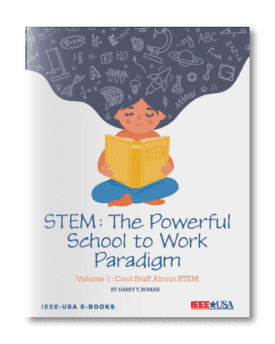
STEM – The Powerful School to Work Paradigm – Vol. 1: Cool Stuff About STEM
FREE to IEEE Members
Non-Members: $2.99
IEEE-USA has launched a two-book series on STEM by prolific author and educator Harry T. Roman. In the first book of the STEM: The Powerful School to Work Paradigm series, Volume 1 – Cool Stuff about STEM, Roman makes a strong case for the value of STEM education to educators, employers, society, and future workers.
Roman argues that strong STEM education can help produce students who:
- Understand The Engineering Design Cycle
- Have experience working in teams
- Have developed transferrable skills
- Are not afraid to invent
- Can manage projects
- Know the importance of documentation
- Assess markets
- Can apply integrated thinking while taking constraints into account
Roman asserts that students with strong STEM skills need less expensive on-the-job training, and can deliver results and productivity for an employer more quickly. He notes, “It makes a big difference when you have access to students who have STEM experience, pre-loaded with information about the engineering profession — and knowledge about the technical terms and processes that can turn raw ideas into profitable products.” He adds, “Students with such skills are even more valuable than those with high GPAs, who may possess little process knowledge about how to organize/manage projects.”
Roman also believes employees should look to hire students with a strong STEM background — due to their ability to communicate and present, their understanding of the value of failure. Further, the skills they have obtained provide a strong foundation for the leadership development.
Volume 1 – Cool Stuff about STEM is the first book in Harry Roman’s STEM: The Powerful School to Work Paradigm series. It is free for all IEEE members at the IEEE-USA Shop, or for $2.99 for non-members.
In this first book, Roman notes the importance of STEM for the overall U.S. economy, citing statistics from the U.S. Department of Commerce, including:
- STEM-rich industries contribute $5 trillion annually to the U.S. economy
- In 2011, STEM exports industries totaled $775 Billion
- Currently, the United States has 26 million STEM jobs — 20% of all U.S. jobs
Roman includes information that should encourage students to look seriously at a STEM career. He emphasizes the unemployment rate for STEM jobs is significantly lower than the overall unemployment rate; and, that by 2025, a projected be 3.5 million STEM jobs will need to be filled.
The author believes in a broad definition of STEM workers that may make these numbers even higher. He includes engineers, physicists and researchers in this list; but he also adds futurists, mathematicians — even artists. Roman notes Renaissance artists were transforming, because they integrated their understanding of science into their art).
A theme appearing in several of Roman’s other works emerges here as well: our educational system needs to move away from its emphasis on teaching facts to teaching both content and process skills. He urges continuing to evolve into a more STEM-based integrated curriculum. Not only does Roman make the case that STEM provides “the ‘relevancy’ to the mere teaching of content,” but he also highlights how STEM education teaches students it is okay to fail. The author contends that by failing, they learn — and improve on their ideas.
IEEE-USA will publish the second book in the STEM: The Powerful School to Work Paradigm series Volume II: Interacting With STEM Teachers will be later this year.
Harry T. Roman holds 12 U.S. patents. He has received numerous engineering, invention and teaching awards; and he has published more than 550 scientific papers, articles and books. Roman was named a Distinguished Technology Educator by New Jersey Technology Education and Engineering Association. IEEE has honored him with a Meritorious Achievement Award for developing continuing education products for IEEE members — as well as with an Outstanding Engineer award. Throughout his engineering career, Roman has worked with schools, bringing the excitement of real-world problem solving to the classroom.
